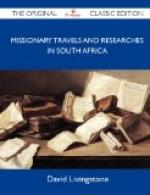The food of the ostrich consists of pods and seeds of different kinds of leguminous plants, with leaves of various plants; and, as these are often hard and dry, he picks up a great quantity of pebbles, many of which are as large as marbles. He picks up also some small bulbs, and occasionally a wild melon to afford moisture, for one was found with a melon which had choked him by sticking in his throat. It requires the utmost address of the Bushmen, crawling for miles on their stomachs, to stalk them successfully; yet the quantity of feathers collected annually shows that the numbers slain must be considerable, as each bird has only a few in the wings and tail. The male bird is of a jet black glossy color, with the single exception of the white feathers, which are objects of trade. Nothing can be finer than the adaptation of those flossy feathers for the climate of the Kalahari, where these birds abound; for they afford a perfect shade to the body, with free ventilation beneath them. The hen ostrich is of a dark brownish-gray color, and so are the half-grown cocks.
The organs of vision in this bird are placed so high that he can detect an enemy at a great distance, but the lion sometimes kills him. The flesh is white and coarse, though, when in good condition, it resembles in some degree that of a tough turkey. It seeks safety in flight; but when pursued by dogs it may be seen to turn upon them and inflict a kick, which is vigorously applied, and sometimes breaks the dog’s back.
Chapter 8.
Effects of Missionary Efforts—Belief in the Deity—Ideas of the Bakwains on Religion—Departure from their Country—Salt-pans—Sour Curd—Nchokotsa—Bitter Waters—Thirst suffered by the wild Animals—Wanton Cruelty in Hunting—Ntwetwe—Mowana-trees—Their extraordinary Vitality—The Mopane-tree—The Morala—The Bushmen—Their Superstitions—Elephant-hunting—Superiority of civilized over barbarous Sportsmen—The Chief Kaisa—His Fear of Responsibility—Beauty of the Country at Unku—The Mohonono Bush—Severe Labor in cutting our Way—Party seized with Fever—Escape of our Cattle—Bakwain Mode of recapturing them—Vagaries of sick Servants— Discovery of grape-bearing Vines—An Ant-eater—Difficulty of passing through the Forest—Sickness of my Companion—The Bushmen—Their Mode of destroying Lions—Poisons—The solitary Hill—A picturesque Valley—Beauty of the Country—Arrive at the Sanshureh River—The flooded Prairies—A pontooning Expedition—A night Bivouac—The Chobe— Arrive at the Village of Moremi—Surprise of the Makololo at our sudden Appearance—Cross the Chobe on our way to Linyanti.




